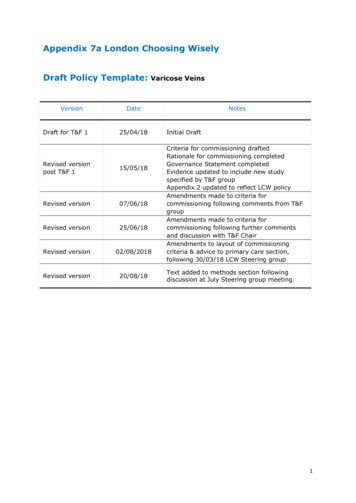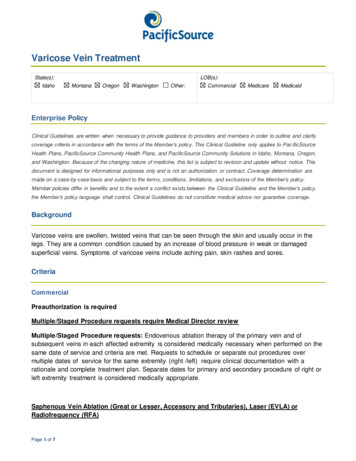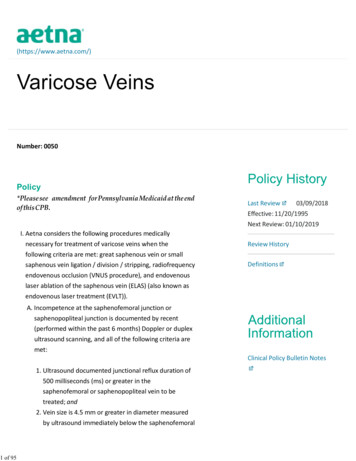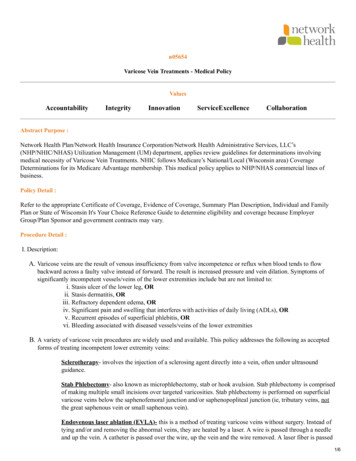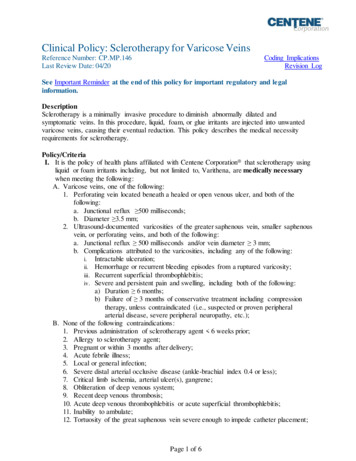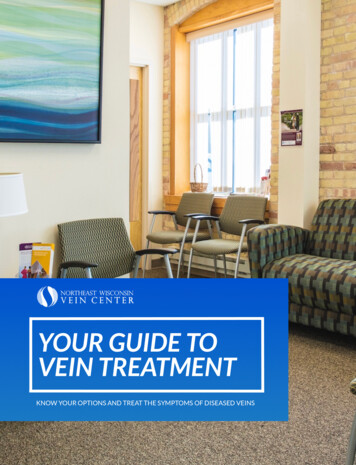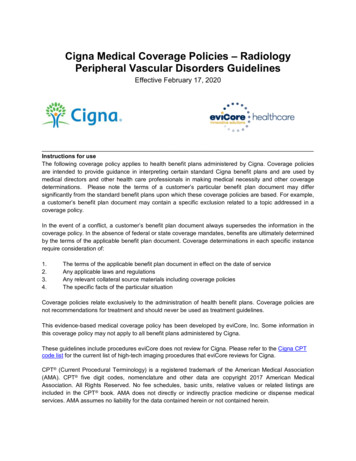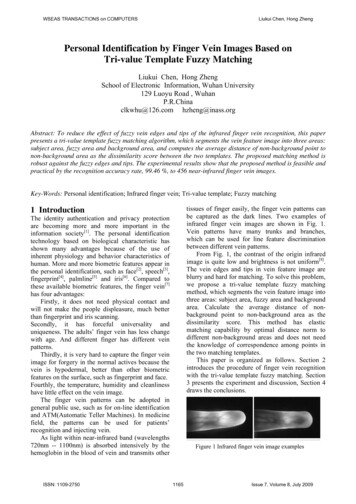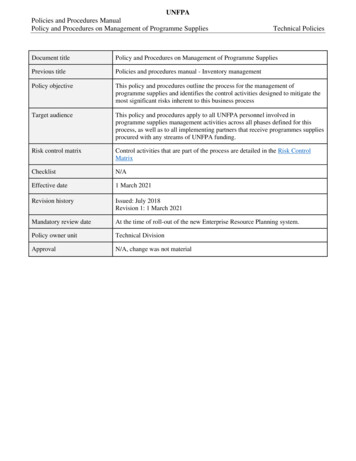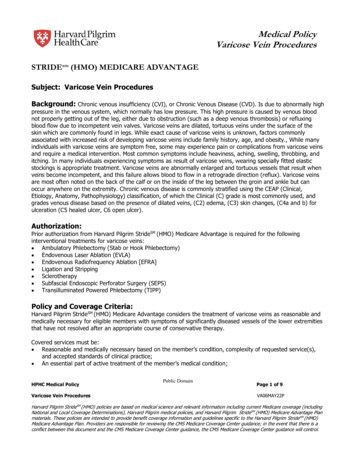
Transcription
Medical PolicyVaricose Vein ProceduresSTRIDEsm (HMO) MEDICARE ADVANTAGESubject: Varicose Vein ProceduresBackground: Chronic venous insufficiency (CVI), or Chronic Venous Disease (CVD). Is due to abnormally highpressure in the venous system, which normally has low pressure. This high pressure is caused by venous bloodnot properly getting out of the leg, either due to obstruction (such as a deep venous thrombosis) or refluxingblood flow due to incompetent vein valves. Varicose veins are dilated, tortuous veins under the surface of theskin which are commonly found in legs. While exact cause of varicose veins is unknown, factors commonlyassociated with increased risk of developing varicose veins include family history, age, and obesity., While manyindividuals with varicose veins are symptom free, some may experience pain or complications from varicose veinsand require a medical intervention. Most common symptoms include heaviness, aching, swelling, throbbing, anditching. In many individuals experiencing symptoms as result of varicose veins, wearing specially fitted elasticstockings is appropriate treatment. Varicose veins are abnormally enlarged and tortuous vessels that result whenveins become incompetent, and this failure allows blood to flow in a retrograde direction (reflux). Varicose veinsare most often noted on the back of the calf or on the inside of the leg between the groin and ankle but canoccur anywhere on the extremity. Chronic venous disease is commonly stratified using the CEAP (Clinical,Etiology, Anatomy, Pathophysiology) classification, of which the Clinical (C) grade is most commonly used, andgrades venous disease based on the presence of dilated veins, (C2) edema, (C3) skin changes, (C4a and b) forulceration (C5 healed ulcer, C6 open ulcer).Authorization:Prior authorization from Harvard Pilgrim StrideSM (HMO) Medicare Advantage is required for the followinginterventional treatments for varicose veins: Ambulatory Phlebectomy (Stab or Hook Phlebectomy) Endovenous Laser Ablation (EVLA) Endovenous Radiofrequency Ablation [EFRA] Ligation and Stripping Sclerotherapy Subfascial Endoscopic Perforator Surgery (SEPS) Transilluminated Powered Phlebectomy (TIPP)Policy and Coverage Criteria:Harvard Pilgrim StrideSM (HMO) Medicare Advantage considers the treatment of varicose veins as reasonable andmedically necessary for eligible members with symptoms of significantly diseased vessels of the lower extremitiesthat have not resolved after an appropriate course of conservative therapy.Covered services must be: Reasonable and medically necessary based on the member’s condition, complexity of requested service(s),and accepted standards of clinical practice; An essential part of active treatment of the member’s medical condition;HPHC Medical PolicyVaricose Vein ProceduresPublic DomainPage 1 of 9VA06MAY22PHarvard Pilgrim StrideSM (HMO) policies are based on medical science and relevant information including current Medicare coverage (includingNational and Local Coverage Determinations), Harvard Pilgrim medical policies, and Harvard Pilgrim StrideSM (HMO) Medicare Advantage Planmaterials. These policies are intended to provide benefit coverage information and guidelines specific to the Harvard Pilgrim StrideSM (HMO)Medicare Advantage Plan. Providers are responsible for reviewing the CMS Medicare Coverage Center guidance; in the event that there is aconflict between this document and the CMS Medicare Coverage Center guidance, the CMS Medicare Coverage Center guidance will control.
Ordered under a plan of care established and reviewed regularly by the attending physician caring for themember; andFurnished by provider(s) with appropriate state licensure, and (if indicated) accreditation/certification from anappropriate accrediting organization.General Eligibility Criteria:Harvard Pilgrim StrideSM (HMO) Medicare Advantage considers interventional treatment for symptomatic varicoseveins as reasonable and medically necessary when medical record documentation confirms ALL the following: The member has symptomatic varicose veins evidenced by ANY of the following:o Significant pain and/or edema that impairs mobility and interferes with activities of daily livingo Stasis dermatitiso Bleeding from a varicosity associated with diseased vessels of the lower extremity or extremitieso Non-healing stasis ulcer of the lower lego Recurrent episodes of superficial phlebitiso Refractory dependent edema; ANDSymptoms of significantly diseased vessels of the lower extremities persist after at least 6 weeks ofconservative therapy including the following components (as indicated):o Weight reduction (if overweight)o Regular exerciseo Periodic leg elevationo Use of appropriate compressive bandages or prescription generated, pressure gradient compressionstockings ( 20-30 mm Hg)o NSAIDs unless contraindicated or not tolerated; ANDDuplex ultrasound of the deep and superficial venous system (performed while patient is standing) confirmsANY of the following:o Reflux 1 second, and venous diameter 3 mm in an axial vein connected to symptomatic varicoseveins, leg ulcer, or area of lipodermatosclerosis;o Nonaxial varicose vein(s) with diameter 3mm (by physical exam or ultrasound);o “Pathologic” perforating veins (i.e., outward flow of 500 msec duration, with a diameter of 3.5mm)located beneath or associated with the ulcer bed, and no post thrombotic deep system incompetence.(Ultrasound documented competency, or confirmation of successful ablation/removal of axial veins isrequired.); ANDRelevant Procedure-Specific Criteria (below) are met.Procedure-Specific Criteria:Harvard Pilgrim StrideSM (HMO) Medicare Advantage considers the following procedures or combination ofprocedures as reasonable and medically necessary when General Eligibility Criteria above are met:ProcedureAmbulatory PhlebectomyMedical Record Must Confirm:ANY of the following: AAGSV with reflux 1 second and venous diameter 3 mm; OR Symptomatic secondary varicosities in the same vein field, inconjunction with, or after a successful main axial superficial veinablation/removal performed within the past yearEndovenous Laser Ablation(EVLA)Criteria 1 AND 2 are met: Patient's anatomy and clinical condition is amenable to theproposed treatment, including ALL the following:HPHC Medical PolicyVaricose Vein ProceduresPublic DomainPage 2 of 9VA06MAY22PHarvard Pilgrim StrideSM (HMO) policies are based on medical science and relevant information including current Medicare coverage (includingNational and Local Coverage Determinations), Harvard Pilgrim medical policies, and Harvard Pilgrim StrideSM (HMO) Medicare Advantage Planmaterials. These policies are intended to provide benefit coverage information and guidelines specific to the Harvard Pilgrim StrideSM (HMO)Medicare Advantage Plan. Providers are responsible for reviewing the CMS Medicare Coverage Center guidance; in the event that there is aconflict between this document and the CMS Medicare Coverage Center guidance, the CMS Medicare Coverage Center guidance will control.
ProcedureNot authorized for patients withobliteration of deep venoussystem, allergy to the sclerosant,or hypercoagulable state.Endovenous RadiofrequencyAblation (RFA)Coverage limited to patients withno significant peripheral arterydisease.Ligation and StrippingNot covered for patients withsevere distal arterial occlusivedisease, obliteration of deepvenous system, allergy to thesclerosant, or hypercoagulablestate.SclerotherapyNot covered for patients withsevere distal arterial occlusivedisease, obliteration of deepvenous system, allergy to thesclerosant, or hypercoagulablestate.Medical Record Must Confirm:o Absence of aneurysm in the target segment;o Maximum vein diameter of 30 mm;o Absence of thrombosis or vein tortuosity which would impaircatheter advancement:o Absence of significant peripheral arterial diseases. EITHER of the following:o Reflux 1 second and venous diameter 3 mm in GSV, SSV,or AAGSV; ORo Pathologic perforator vein directly associated with a venousulcerCriteria 1 AND 2 are met: Patient's anatomy and clinical condition is amenable to theproposed treatment including ALL the following:o Absence of aneurysm in the target segment;o Maximum vein diameter of 20 mm; ANDo Absence of thrombosis or vein tortuosity, which would impaircatheter advancement. EITHER of the following:o Reflux 1 second and venous diameter 3 mm in GSV, SSV,or AAGSV; ORo Pathologic perforator vein directly associated with a venousulcerALL the following: Reflux 1 second; Venous diameter 3 mm in GSV, SSV, or AAGSVEITHER of the following: Symptomatic secondary varicosities in vessels less than 4 mm indiameter (in the same vein field), in conjunction with, or after,successful main axial superficial vein ablation/removal performedwithin the past year; Pathologic perforator vein directly associated with a venous ulcer(Sclerotherapy usually performed with Duplex guidance)Subfascial Interruption orSubfascial EndoscopicPerforator Vein Surgery(SEPS)Pathologic perforator vein(s) directly associated with a venous ulcer.Transilluminated PoweredANY of the following:HPHC Medical PolicyVaricose Vein ProceduresPublic DomainPage 3 of 9VA06MAY22PHarvard Pilgrim StrideSM (HMO) policies are based on medical science and relevant information including current Medicare coverage (includingNational and Local Coverage Determinations), Harvard Pilgrim medical policies, and Harvard Pilgrim StrideSM (HMO) Medicare Advantage Planmaterials. These policies are intended to provide benefit coverage information and guidelines specific to the Harvard Pilgrim StrideSM (HMO)Medicare Advantage Plan. Providers are responsible for reviewing the CMS Medicare Coverage Center guidance; in the event that there is aconflict between this document and the CMS Medicare Coverage Center guidance, the CMS Medicare Coverage Center guidance will control.
ProcedurePhlebectomy (TIPP)Medical Record Must Confirm: AAGSV with reflux 1 second and venous diameter 3 mm; OR Symptomatic secondary varicosities (in the same vein field) inconjunction with, or after a successful main axial superficial veinablation/removal performed within the past year. (TIPP authorizedfor remaining veins 3mm in size)Exclusions:Harvard Pilgrim StrideSM (HMO) Medicare Advantage considers varicose vein procedures as not medicallynecessary for all other indications. In addition, HPHC does not cover: Interventional treatment of symptomatic varicosities without documentation of a failed six-week trial ofconservative therapy Sclerotherapy for cosmetic purposes Experimental and/or investigational treatments Reinjection following recanalization or failure of vein closure without recurrent signs or symptoms Sclerotherapy of the saphenous vein at its junction with the deep system Non-compressive sclerotherapy Compressive sclerotherapy for large, extensive or truncal varicosities Sclerotherapy, ligation and/or stripping of varicose veins, or endovenous ablation therapy for patients withsevere distal arterial occlusive disease; obliteration of deep venous system; an allergy to the sclerosant or ahypercoagulable state Any interventional treatment that uses equipment or sclerosants not approved for such purposes by the FDA Laser ablation of veins with a diameter greater than 20 mm Endovenous ablation therapy in the presence of thrombosis or venous tortuosity which would impair catheteradvancement Treatment of spider veins/telangiectasias for cosmetic purposes Interventional treatment of asymptomatic varicosities for cosmetic purposes Interventional treatment for varicose veins that develop or worsen during pregnancyCoding:Codes are listed below for informational purposes only, and do not guarantee member coverage orprovider reimbursement. The list may not be all-inclusive. Deleted codes and codes which are noteffective at the time the service is rendered may not be eligible.CPT Code36465DescriptionInjection of non-compounded foam sclerosant with ultrasound compression maneuversto guide dispersion of the injectate, inclusive of all imaging guidance and monitoring;single incompetent extremity truncal vein (e.g., great saphenous vein, accessorysaphenous vein)36466Injection of non-compounded foam sclerosant with ultrasound compression maneuversto guide dispersion of the injectate, inclusive of all imaging guidance and monitoring;multiple incompetent truncal veins (e.g., great saphenous vein, accessory saphenousvein), same legInjection(s) of sclerosant for spider veins (telangiectasia), limb or trunk36468HPHC Medical PolicyVaricose Vein ProceduresPublic DomainPage 4 of 9VA06MAY22PHarvard Pilgrim StrideSM (HMO) policies are based on medical science and relevant information including current Medicare coverage (includingNational and Local Coverage Determinations), Harvard Pilgrim medical policies, and Harvard Pilgrim StrideSM (HMO) Medicare Advantage Planmaterials. These policies are intended to provide benefit coverage information and guidelines specific to the Harvard Pilgrim StrideSM (HMO)Medicare Advantage Plan. Providers are responsible for reviewing the CMS Medicare Coverage Center guidance; in the event that there is aconflict between this document and the CMS Medicare Coverage Center guidance, the CMS Medicare Coverage Center guidance will control.
3778537799Injection of sclerosing solution; single veinInjection of sclerosing solution; multiple veins, same legEndovenous ablation therapy of incompetent vein, extremity, inclusive of all imagingguidance and monitoring, percutaneous, mechanochemical; first vein treatedEndovenous ablation therapy of incompetent vein, extremity, inclusive of all imagingguidance and monitoring, percutaneous, mechanochemical; subsequent vein(s) treatedin a single extremity, each through separate access sites (List separately in addition tocode for primary procedure)Endovenous ablation therapy of incompetent vein, extremity, inclusive of all imagingguidance and monitoring, percutaneous, radiofrequency; first vein treatedEndovenous ablation therapy of incompetent vein, extremity, inclusive of all imagingguidance and monitoring, percutaneous, radiofrequency; second and subsequent veinstreated in a single extremity, each through separate access sites (List separately inaddition to code for primary procedure)Endovenous ablation therapy of incompetent vein, extremity, inclusive of all imagingguidance and monitoring, percutaneous, laser; first vein treatedEndovenous ablation therapy of incompetent vein, extremity, inclusive of all imagingguidance and monitoring, percutaneous, laser; second and subsequent veins treated in asingle extremity, each through separate access sites (List separately in addition to codefor primary procedure)Endovenous ablation therapy of incompetent vein, extremity, by transcatheter delivery ofa chemical adhesive (e.g., cyanoacrylate) remote from the access site, inclusive of allimaging guidance and monitoring, percutaneous; first vein treatedEndovenous ablation therapy of incompetent vein, extremity, by transcatheter delivery ofa chemical adhesive (e.g., cyanoacrylate) remote from the access site, inclusive of allimaging guidance and monitoring, percutaneous; subsequent vein(s) treated in a singleextremity, each through separate access sites (List separately in addition to code forprimary procedure)Vascular endoscopy, surgical, with ligation of perforator veins, subfascial (SEPS)Ligation and division of long saphenous vein at saphenofemoral junction, or distalinterruptionsLigation, division, and stripping, short saphenous veinLigation, division, and stripping, long (greater) saphenous veins from saphenofemoraljunction to knee or belowLigation and division and complete stripping of long or short saphenous veins withradical excision of ulcer and skin graft and/or interruption of communicating veins oflower leg, with excision of deep fasciaLigation of perforator veins, subfascial, radical (Linton type), including skin graft, whenperformed, open,1 legLigation of perforator vein(s), subfascial, open, including ultrasound guidance, whenperformed, 1 legStab phlebectomy of varicose veins, 1 extremity; 10-20 stab incisionsStab phlebectomy of varicose veins, 1 extremity; more than 20 incisionsLigation and division of short saphenous vein at saphenopopliteal junction (separateprocedure)Ligation, division, and/or excision of varicose vein cluster(s), 1 legUnlisted procedure, vascular surgeryHPHC Medical PolicyVaricose Vein ProceduresPublic DomainPage 5 of 9VA06MAY22PHarvard Pilgrim StrideSM (HMO) policies are based on medical science and relevant information including current Medicare coverage (includingNational and Local Coverage Determinations), Harvard Pilgrim medical policies, and Harvard Pilgrim StrideSM (HMO) Medicare Advantage Planmaterials. These policies are intended to provide benefit coverage information and guidelines specific to the Harvard Pilgrim StrideSM (HMO)Medicare Advantage Plan. Providers are responsible for reviewing the CMS Medicare Coverage Center guidance; in the event that there is aconflict between this document and the CMS Medicare Coverage Center guidance, the CMS Medicare Coverage Center guidance will control.
9397093971Duplex scan of extremity veins including responses to compression and othermaneuvers; complete bilateral studyDuplex scan of extremity veins including responses to compression and othermaneuvers; unilateral or limited studyReferences:1. Barwell JR, Davies CE, Deacon J, et al. Comparison of surgery and compression with compression alone inchronic venous ulceration (ESCHAR study): randomised controlled trial. Lancet.2004; 363(9424):1854-1859.2. Bergan JJ, Schmid-Schonbein GW, Coleridge Smith PD, et al. Chronic venous disease. N Engl JMed.2006;355:488-498.3. Bianchi C, Ballard JL, Abou-Zamzam A, et al. Subfascial endoscopic perforator vein surgery combined withsaphenous vein ablation: results and critical analysis. J Vasc Surg.2003;38(1):67-71.4. Blaise S, Bosson JL, Diamand JM. Ultrasound-guided sclerotherapy of the great saphenous vein with 1% vs3% polidocanol foam: a multicentre double-blind randomised trial with 3-year follow-up. Eur J Vasc EndovascSurg. 2010;39(6):779-786.5. Blomgren L, Johansson G, Dahlberg-Akerman A, et al. Changes in superficial and perforating vein reflux aftervaricose vein surgery. J Vasc Surg.2005;42(2):315-320.6. Chetter IC, Mylankal KJ, Hughes H, Fitridge R. Randomized clinical trial comparing multiple stab incisionphlebectomy and transilluminated powered phlebectomy for varicose veins. Br J Surg. 2006;93(2):169-174.7. Christenson JT, Gueddi S, Gemayel G, et al. Prospective randomized trial comparing endovenous laserablation and surgery for treatment of primary great saphenous varicose weins with a 2-year follow-up. J VascSurg. 2010;52(5):1234-1241.8. CMS LCD: Treatment of Varicose Veins of the Lower Extremities (L34536).9. CMS Local Coverage Determination (LCD): Treatment of Varicose Veins of the Lower Extremity (L33575).10. Code of Federal Regulations: Title 42 - Public Health Chapter IV - Centers for Medicare & Medicaid ServicesDepartment Of Health And Human Services, Subchapter B - MEDICARE PROGRAM, Part 410SUPPLEMENTARY MEDICAL INSURANCE (SMI) Benefits, Subpart C - Home Health Services Under SMI.11. Coleridge Smith P. Sclerotherapy and foam sclerotherapy for varicose veins. Phlebology. 2009;24(6):260-269.12. Elias S, Khilnani N. Treating the small saphenous vein. Endovasc Today.2008;7(8):60-64.13. Frullini A, Avezzi A. Sclerosing foam in the treatment of varicose veins and telangiectasias: history andanalysis of safety and complications. Dermatol Surg.2002:28(1):11-15.14. Gloviczki P, Camerota AJ, Dalsing MC, et al. The care of patients with varicose veins and associated chronicvenous diseases: clinical practice guidelines of the Society for Vascular Surgery and the American VenousForum. J Vasc Surg. 2011;53(5 Suppl):2S-48S.15. Gohel MS, Barwell JR, Taylor M et al. Long-term results of compression therapy alone versus compressionpluc surgery in chronic venous ulceration (ESCHAR): randomised controlled trial. BMJ. 2007;335(7610):83.16. Hamel-Desnos C, Allaert FA. Liquid versus foam sclerotherapy. Phlebology. 2009; 24(6):240-246.17. Hirsch SA, Dillavou E. Options in the management of varicose veins, 2008. J Cardiovasc Surg (Torino).2008;49(1):19-26.18. Hoggan BL, Cameron AL, Maddern GJ. Systematic review of endovenous laser therapy versus surgery for thetreatment of saphenous varicose veins. Ann Vasc Surg. 2009; 23(2):277-287.19. Howard DP, Howard A, Kothari A, et al. The role of superficial venous surgery in the management of venousulcers: a systematic review. Eur J Vasc Endovasc Surg. 2008;36(4):458-465.20. Jia X, Mowatt G, Burr J. Systematic review of foam sclerotherapy for varicose veins. Br J Surg.2007;94(8):925-936.21. Kalra M, Gloviczki P, Noel AA, et al. Subfascial endoscopic perforator vein surgery in patients with postthrombotic venous insufficiency – is it justified? Vasc Endovascular Sur.2002;36(1):41-50.22. Khilnani N, Grassi C, Kundu S, et al. Multi-society consensus quality improvement guidelines for the treatmentof lower extremity superficial venous insufficiency with endovenous thermal ablation from the Society ofHPHC Medical PolicyVaricose Vein ProceduresPublic DomainPage 6 of 9VA06MAY22PHarvard Pilgrim StrideSM (HMO) policies are based on medical science and relevant information including current Medicare coverage (includingNational and Local Coverage Determinations), Harvard Pilgrim medical policies, and Harvard Pilgrim StrideSM (HMO) Medicare Advantage Planmaterials. These policies are intended to provide benefit coverage information and guidelines specific to the Harvard Pilgrim StrideSM (HMO)Medicare Advantage Plan. Providers are responsible for reviewing the CMS Medicare Coverage Center guidance; in the event that there is aconflict between this document and the CMS Medicare Coverage Center guidance, the CMS Medicare Coverage Center guidance will control.
.40.41.42.Interventional Radiology, Cardiovascular Interventional Radiology Society of Europe, American College ofPhlebology, and Canadian Interventional Radiology Society. J Vasc Interv Radiol.2010;21(1):14-31.Klem TM, Schnater JM, Schutte PR, et al. A randomized trial of cryo stripping versus conventional stripping ofthe great saphenous vein. J Vasc Surg. 2009;49(2):403-409.Kundu S, Lurie F, Millward SF, et al. Recommended reporting standards for endovenous ablation for thetreatment of venous insufficiency: joint statement of the American Venous Forum and the Society ofInterventional Radiology. J Vasc Interv Radiol. 2007;18(9):1073-1080.Laredo J, Lee BB, Neville RF. Endovenous thermal ablation of the anterior accessory great saphenous vein.Endovasc Today.2010;9(3):36-39.Leopardi D, Hoggan B, Fitridge R, et al. Systematic review of treatments for varicose veins. Ann VascSurg.2009;23(2):264-276.Liquid, foam, and glue sclerotherapy techniques for the treatment of lower extremity veins.UpToDate.com/login [via subscription only]. Accessed April 2, 2021.Luebke T, Brunkwall J. Meta-analysis of subfascial endoscopic perforator vein surgery (SEPS) for chronicvenous insufficiency. Phlebology.2009;24(1): 8-16.Luebke T, Brunkwall J. Meta-analysis of transilluminated powered phlebectomy for superficial varicosities. JCardiovasc Surg (Torino). 2008;49(6):757-764.Luebke T, Brunkwall J. Systematic review and meta-analysis of endovenous radiofrequency obliteration,endovenous laser therapy, and foam sclerotherapy for primary varicosis. J Cardiovasc Surg (Torino).2008;49(2):213-233.Luebke T, Gawenda M, Heckencamp J, et al. Meta-analysis of endovenous radiofrequency obliteration of thegreat saphenous vein in primary varicosis. J Endovasc Ther. 2008;15(2):213-223.Meissner MH, Gloviczki P, Bergan, et al. Primary chronic venous disorders. J Vasc Surg.2007;46 Suppl S:54S67S.Merchant RF, Pichot O. Long-term outcomes of endovenous radiofrequency obliteration of saphenous refluxas a treatment for superficial venous insufficiency. J Vasc Surg. 2005; 42(3):502-509.Michaels JA, Campbell WB, Brazier JE, et al. Randomised clinical trial, observational study and assessment ofcost-effectiveness of the treatment of varicose veins (REACTIV trial). Health Technol Assess. 2006;10(13):1196, iii-iv.Morrison N, Gibson K, McEnroe S, et al. Randomized trial comparing cyanoacrylate embolization andradiofrequency ablation for incompetent great saphenous veins (VeClose). J Vasc Surg. Apr 2015;61(4):985994.Myers KA, Jolley D. Factors affecting the risk of deep venous occlusion after ultrasound-guided sclerotherapyfor varicose veins. Eur J Vasc Endovasc Surg. 2008; 36(5):602-605.National Institute for Health and Clinic Excellence (NICE). Ultrasound-guided foam sclerotherapy for varicoseveins; IPG 314. [NICE Web site]. August 2009. Available at: https://www.nice.org.uk/guidance/ipg440.Accessed April 2, 2022.National Institute for Health and Clinical Excellence (NICE). Endovenous laser treatment of the longsaphenous vein. Interventional procedure guidance IPG52. [NICE Web site]. March 2004. Available at:https://www.nice.org.uk/guidance/ipg52. Accessed April 2, 2022.National Institute for Health and Clinical Excellence (NICE). Radiofrequency ablation of varicose veins.Interventional procedure guidance IPG8. [NICE Web site]. September 2003.https://www.nice.org.uk/guidance/ipg8. Accessed April 2, 2022.Nelzén O, Fransson I. True long-term healing and recurrence of venous leg ulcers following SEPS combinedwith superficial venous surgery: a prospective study. Eur J Vasc Endovasc Surg. 2007;34(5):605-12.Nelzén O. Prospective study of safety, patient satisfaction and leg ulcer healing following saphenous andsubfascial endoscopic perforator surgery. Br J Surg.2000;87(1):86-91.Nicolaides A, Allegra C, Bergan J, et al. Management of chronic venous disorders of the lower limbs.Guidelines according to scientific evidence. Int Angiol.2008;27(1):1-59.HPHC Medical PolicyVaricose Vein ProceduresPublic DomainPage 7 of 9VA06MAY22PHarvard Pilgrim StrideSM (HMO) policies are based on medical science and relevant information including current Medicare coverage (includingNational and Local Coverage Determinations), Harvard Pilgrim medical policies, and Harvard Pilgrim StrideSM (HMO) Medicare Advantage Planmaterials. These policies are intended to provide benefit coverage information and guidelines specific to the Harvard Pilgrim StrideSM (HMO)Medicare Advantage Plan. Providers are responsible for reviewing the CMS Medicare Coverage Center guidance; in the event that there is aconflict between this document and the CMS Medicare Coverage Center guidance, the CMS Medicare Coverage Center guidance will control.
43. O'Donnell TF, Jr. The present status of surgery of the superficial venous system in the management ofvenous ulcer and the evidence for the role of perforator interruption. J Vasc Surg. 2008;48(4):1044-1052.44. Ouvry P, Allaert FA, Desnos P, et al. Efficacy of polidocanol foam versus liquid in sclerotherapy of the greatsaphenous vein: a multicentre randomised controlled trial with a 2- year follow-up. Eur J Vasc Endovasc Surg.2008;36(3):366-370.45. Palm MD, Guiha IC, Goldman MP. Foam sclerotherapy for reticular veins and nontruncal varicose veins of thelegs: a retrospective review of outcomes and adverse effects. Dermatol Surg.2010;36:1026-1033.46. Pierik EG, van Urk H, Hop WC, et al. Endoscopic versus open subfascial division of incompetent perforatingveins in the treatment of venous leg ulceration: a randomized trial. J Vasc Surg.1997;26(6):1049-1054.47. Rabe E, Otto J, Schliephake D, et al. Efficacy and safety of great saphenous vein sclerotherapy usingstandardized polidocanol foam (ESAF): a randomised controlled multicentre clinical trial. Eur J Vasc EndovascSurg. 2008;35(2):238-245.48. Raju S, Neglen P. Clinical practice. Chronic venous insufficiency and varicose veins. N Engl JMed.2009;360(22):2319-2327.49. Rasmussen LH, Bjoern L, Lawaetz M, et al. Randomised clinical trial comparing endovenous laser ablationwith stripping of the great saphenous vein: clinical outcome and recurrence after 2 years. Eur J EndovascSurg. 2010;39(5):630-635.50. Rutgers PH, Kitslaar PJ. Randomized trial of stripping versus high ligation combined with sclerotherapy in thetreatment of the incompetent greater saphenous vein. Am J Surg. 1994;168(4):311-315.51. Sato DT, Goff CD, Gregory RT, et al. Subfascial perforator vein ablation: comparison of open versusendoscopic techniques. J Endovsac Surg.1999;6(2):147-154.52. Society of Interventional Radiology (SIR). Position statement on endovenous ablation. December 2003.Available at: http://www.sirweb.org/clinical/cpg/SIR venous ablation statement Final2015.pdf. AccessedApril 2, 2022.53. Sparks SR, Ballard JL, Bergan JJ, et al. Early benefits of subfascial endoscopic perforator surgery (SEPS) inhealing venous ulcers. Ann Vasc Surg.1997;11(4):367-373.54. Stuart WP, Adam DJ, Allan PL, et al. Saphenous surgery does not correct perforator incompetence in thepresence of deep venous reflux. J Vasc Surg.1998;28(5):834-83.855. Stucker M, Kobus S, Altmeyer P, Reich-Schupke S. Review of published information on foam sclerotherapy.Dermatol Surg.2010;36:983-992.56. Tenbrook JA, Iafrati MD, O’Donnell TF et al. Systematic review of outcomes after surgical management ofvenous disease incorporating subfascial endoscopic perforator surgery. J Vasc Surg.2004;39(3):583-589.57. Theivacumar NS, Darwood R, Gough MJ. Neovascularisation and recurrence 2 years after varicose veintreatment for sapheno-femoral and great saphenous vein reflux: a comparison of surgery and endovenouslaser ablation. Eur J Vasc Endovasc Surg. 2009; 38(2):203-207.58. T
Background: Chronic venous insufficiency (CVI), or Chronic Venous Disease (CVD). Is due to abnormally high pressure in the venous system, which normally has low pressure. This high pressure is caused by venous blood . CPT Code Description 36465 Injection of non-compounded foam sclerosant with ultrasound compression maneuvers
